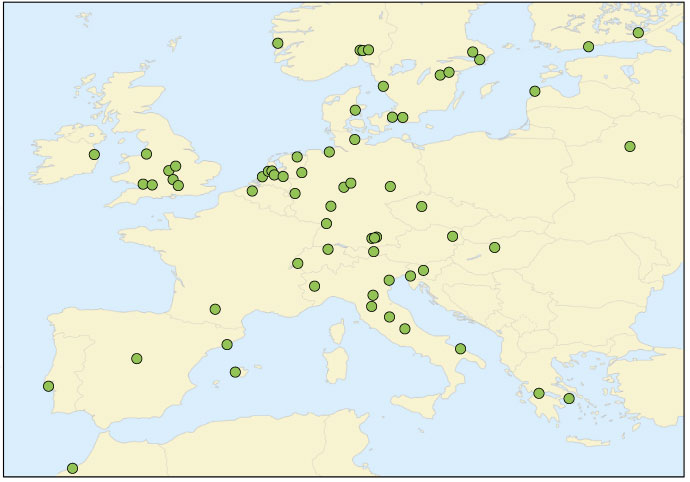The OpenIFS activity at ECMWF marked ten years in December 2021. It began in 2011, aiming to provide and support versions of the operational Integrated Forecasting System (IFS) for research, education and training in numerical weather prediction and meteorology by Member and Co-operating States and academic institutes.
Motivation
The original motivation behind OpenIFS remains relevant today and is in line with ECMWF’s strategy of close partnership with the meteorological community. A key objective was to deliver benefit to Member and Co-operating State users, the wider community and ECMWF. Over the last ten years, OpenIFS has: produced improvements in the IFS; established a growing user community amongst Member and Co-operating States; enabled new collaborations; increased research and training opportunities in universities; created an international scientific workshop series; and improved knowledge of the IFS and ECMWF in the wider meteorological community.
It was clear that ease-of-use, good support, and training were essential for external use of the IFS to be successful. These priorities have focused OpenIFS efforts to make the IFS, a complex operational numerical weather prediction model, easy to use externally to ECMWF. They have also led to significant engagement with the meteorological community to provide training and support. OpenIFS provides online user guides, public forums for users to ask questions, a dedicated support team at ECMWF, and training events.
OpenIFS compared with the IFS
Updates to operational versions of the IFS occur at least yearly, but OpenIFS releases are less frequent, on a timescale typical of university research projects, and focus instead on producing releases to coincide with significant upgrades of the IFS.
To date, three versions of the IFS have been made available at upgrade Cycles 38r1, 40r1 and 43r3. The OpenIFS model has the exact same deterministic and ensemble forecast capability as the operational IFS. It includes the wave and surface components but does not include the data assimilation nor the observation handling components of the IFS. This makes the model easier to provide externally and simpler to use. At the current time, the ocean model NEMO is also not included, although it is hoped that this may be possible in the future.
Research and teaching applications
Overall, the number and range of research and teaching applications using OpenIFS over the last ten years are impressive. As expected, it has been used in a broad range of numerical weather prediction (NWP) studies, such as high-impact weather event and diagnostic studies. Many of these studies have been published in the peer-reviewed literature or as ECMWF Newsletter articles. OpenIFS has also been the focus of several Earth system modelling groups. The EC-Earth consortium (www.ec-earth.org) includes 30 research institutes from 12 European countries to collaborate on the development of an Earth system model. They have chosen the OpenIFS model as the atmospheric component of their next model release, whilst other research groups are working to build their own Earth system models based on OpenIFS (see ECMWF Newsletter No. 164).
OpenIFS has also played a key role in collaboration with the University of Oxford on the use of reduced precision in the IFS. This led to significant savings in computing resources at ECMWF for operational forecasting. OpenIFS was ideal for the proof-of-concept development as its reduced code base allowed rapid prototyping and testing.
An objective of OpenIFS is to contribute towards meeting education and training needs both at ECMWF and for licensed users. Whilst some use of OpenIFS in teaching was anticipated, the number of universities using OpenIFS in advanced-level teaching is more than originally expected. OpenIFS has clearly enabled a bridge between theoretical teaching and the practical experience of using a world-leading forecast model.
OpenIFS user workshops
An OpenIFS workshop series was created to provide a forum for OpenIFS users to meet, to learn about OpenIFS, and to highlight ECMWF research. To date, there have been five such workshops (Helsinki, Stockholm, ECMWF, Trieste, Reading), which have rapidly grown from small local workshops to five-day international workshops with invited speakers. Participants use the OpenIFS model to explore interesting case studies on the theme of the workshop. The case studies in the OpenIFS workshop series provide tutorials and practical examples where the model configuration is altered to examine its impact on the case study forecast. Some universities have adapted this material for their own use.

Future
The biggest hurdle to using OpenIFS has been the generation of the model’s initial conditions. This is best done at ECMWF, where the system ‘knows’ how best to produce balanced states from the various analyses available. A new web facility is under development, which will allow users to generate their own initial states rather than requesting them from the OpenIFS support team (see ECMWF Newsletter No. 168). Other plans include investigating the addition of the NEMO ocean model as used in ECMWF operational forecasts, to support seasonal and longer timescales, and incorporating the atmospheric composition capability from the EU‑funded Copernicus Atmosphere Monitoring Service (CAMS) operated by ECMWF.
Over the last ten years OpenIFS has established a growing community of users, generated impact at ECMWF, universities and other research institutes, and established an international workshop series. Given these achievements, together with ongoing plans, we are sure OpenIFS has an exciting future and can continue to provide a valuable link between ECMWF and the wider community to the benefit of both.

